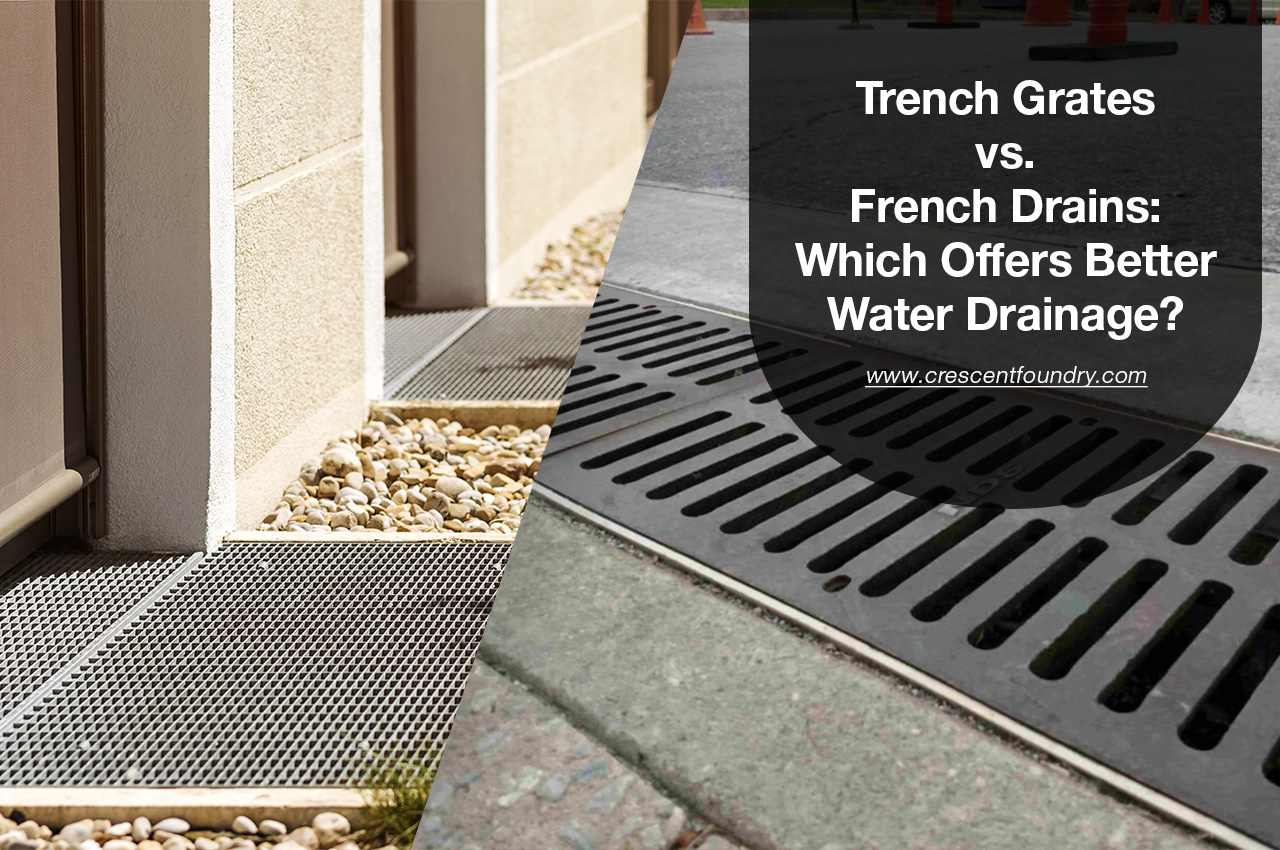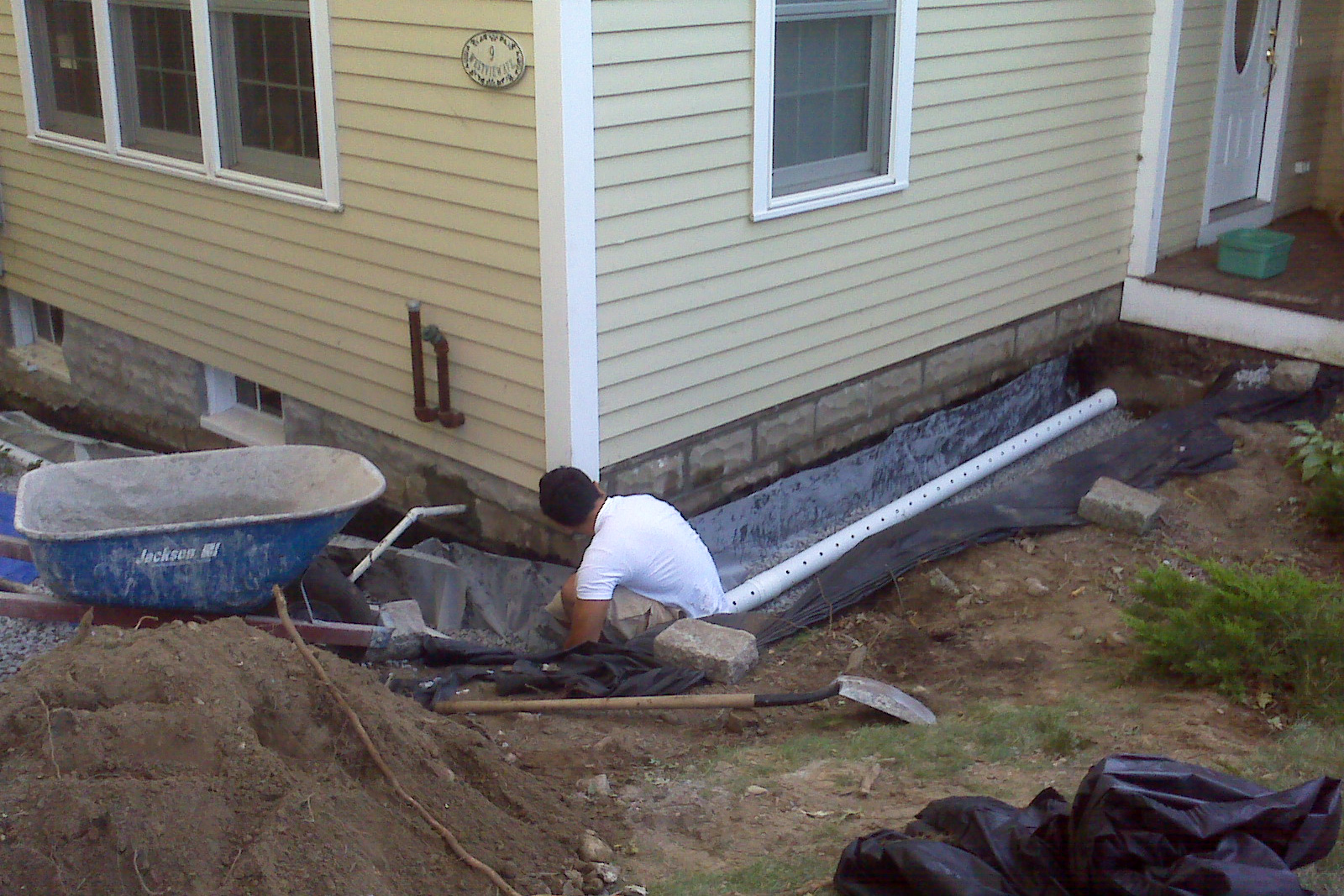Evaluating DIY vs. Professional Portland French Drain Construction
Evaluating DIY vs. Professional Portland French Drain Construction
Blog Article
Just How a French Drain Can Assist Prevent Water Damages in Your Cellar
If you're managing a moist basement, a French drainpipe could be the remedy you need. Portland French Drain. This system successfully reroutes water away from your structure, aiding to avoid costly damages. Understanding just how it functions and recognizing the indicators that you need one can make a considerable distinction in your home's security and convenience. Yet prior to you decide, it's vital to discover the benefits and setup process to see if it's the appropriate suitable for your circumstance
What Is a French Drain?
A French drain is a simple yet reliable option for handling excess water around your property. It's made to reroute water away from susceptible locations, like your cellar or structure. Normally, it contains a trench loaded with crushed rock and a perforated pipe that gathers and networks water. When rain or groundwater develops, the drainpipe efficiently guides it away, protecting against prospective damage.You could see French drains pipes mounted along residential property lines, driveways, or even near your home's structure. They are available in different dimensions and configurations, making them versatile to different landscapes and water drainage requirements. Installing a French drain can aid you avoid pricey repairs and secure your home's architectural stability. If you've been dealing with water merging or soggy locations in your backyard, a French drainpipe could be the solution you require. It's an aggressive action to guarantee your building stays dry and secure from water-related concerns.
Just how Does a French Drain Job?
When water collects around your residential property, a French drain kicks right into activity to reroute it properly. This system includes a trench filled up with crushed rock and a perforated pipe near the bottom. The pipe gathers excess water from the dirt and networks it away from your foundation.As rain or groundwater seeps right into the crushed rock, it moves with the openings and into the pipe. Gravity does the job, drawing the water away from your cellar and guiding it to an assigned drain area, like a tornado drainpipe or completely dry well.You can install a French drainpipe either inside or outside your home. It'll protect against water from merging near your structure if you choose an exterior configuration. An interior drain will catch water that seeps with your basement walls. This reliable style keeps your room completely dry, permitting you to appreciate your home without the worry of water damages.
Benefits of Mounting a French Drain
Installing a French drainpipe can greatly enhance your home's resilience against water damages. You'll appreciate effective water diversion, which aids lower mold and mildew growth and safeguard your residential property. Plus, a properly maintained drain system can also improve your property's worth.
Effective Water Diversion

Reduced Mold Development
Since wetness develops a perfect environment for mold to thrive, reducing water accumulation around your home is essential for preserving a healthy and balanced living room. Installing a French drainpipe properly channels excess water far from your foundation, keeping your cellar completely dry. This positive measure greatly decreases moisture levels, making it harder for mold spores to work out and grow.With less wetness, you'll find it easier to take a breath and appreciate a clean, secure environment. And also, you'll decrease the threat of health and wellness problems connected with mold and mildew exposure, such as allergic reactions and respiratory system issues. By buying a French drainpipe, you're taking an essential action toward a mold-free basement, guaranteeing that your home remains a comfortable area for you and your household.
Boosted Residential Or Commercial Property Worth
A French drainpipe can significantly enhance your home's value, making it a wise investment for homeowners. When prospective purchasers see a well-maintained basement devoid of water damage, they're more probable to be impressed. This function not just improves your home's appeal however additionally signifies that you've taken positive steps to shield it. By lowering the danger of water-related problems, your residential or commercial property ends up being extra appealing in an affordable market, commonly leading to greater offers. Additionally, the long-term cost savings on repairs and maintenance can convert right into boosted equity. Installing a French drainpipe shows you appreciate your home's stability, assuring purchasers that they're making an audio purchase. Inevitably, it's an important addition that view it pays off in even more methods than one.
Signs You Required a French Drainpipe
If you see relentless water buildup in your yard or basement, it's a clear sign that you could require a French drainpipe. In addition, a musty smell can show trapped dampness, which can lead to bigger problems. Dealing with these indications early can assist avoid serious water damages to your home.
Persistent Water Buildup
It's a clear indication that a French drain could be needed when you discover relentless article source water build-up around your home. Water merging near your foundation can result in substantial damage gradually, including architectural concerns and mold development. You need to pay interest to locations where water seems to gather after heavy rainfalls or snowmelt. If your backyard stays soggy for days, it's time to do something about it. Additionally, seek indicators of erosion or muddy patches, as these can show inadequate water drainage. Setting up a French drain assists reroute water away from your home, shielding your structure and minimizing the risk of water damages. Don't wait on larger issues to arise-- resolving water buildup currently can save you pricey repair work later on.
Stuffy Odor Existence
Relentless water buildup commonly leads to greater than simply noticeable pooling; it can create a setting ripe for musty smells. If you discover a damp, stale scent in your cellar, it's an indication that moisture is sticking around, usually as a result of poor drainage. This odor generally shows mold and mildew or mildew growth, which can pose wellness dangers and damage your belongings. You may discover that the smell intensifies throughout damp climate or after hefty rains. If you're battling persistent mildewy odors, it's time to assess a French drainpipe. This system redirects water away from your foundation, decreasing dampness levels and combating those unpleasant scents. Don't neglect this warning sign; resolving it immediately can save you from more substantial water damage down the line.
The Installment Process of a French Drain
Setting up a French drain can be an uncomplicated process that substantially boosts your home's water damages prevention. First, review the area where you wish to mount the drain, guaranteeing it slopes far from your structure. Next, mark the trench's course, which should have to do with 6-8 inches broad and 18-24 inches deep.Excavate the trench, eliminating dirt as required. Portland French Drain. When you have actually obtained your trench, put down landscape material to stop soil from obstructing the drain. Include a layer of gravel at the bottom. Area a perforated pipe on top of the crushed rock, making certain the openings encounter downward for effective drainage.Cover the pipeline with more gravel, leaving about 3 inches of space at the top. Fold up the landscape textile over the crushed rock to protect it. Ultimately, fill in the trench with dirt, compacting it as you go. You have actually now set up a dependable system to reroute water far from your basement!
Upkeep Tips for Your French Drainpipe
Although a French drainpipe is made to effectively handle next page water circulation, regular upkeep is important to validate its continued efficiency. Beginning by evaluating the drain and its environments for particles or blockages. Clear any fallen leaves, dust, or debris that might build up, particularly after hefty rains.Next, check the outlet for appropriate drain. It needs to route water away from your foundation-- if it doesn't, you may require to readjust its placement. In addition, verify that the gravel surrounding the drain is intact and hasn't cleared up gradually; this aids keep correct water flow.Consider scheduling an annual professional evaluation to catch any type of problems early. If you observe any kind of indicators of water damages or merging, resolve them quickly to stay clear of bigger troubles in the future. With a little attention, your French drain can effectively protect your cellar for several years ahead.
Price Factors To Consider and Long-Term Cost Savings
When thinking about a French drain, it's crucial to consider both the first financial investment and the long-lasting savings it can provide. While the ahead of time price may seem substantial, assume regarding it as an investment in your house's future. Setting up a French drain generally varies from $1,500 to $5,500, depending upon your basement's dimension and the intricacy of the installation.However, this cost can conserve you thousands in prospective water damage, mold and mildew remediation, and foundation fixings. By stopping water accumulation, you're additionally securing your home's value and staying clear of expensive insurance cases. Furthermore, a completely dry basement can lower your power bills, as wetness can result in increased home heating and cooling prices. Eventually, the peace of mind that includes knowing your home is secured from water damage is invaluable. Think about these variables thoroughly to make an educated decision that benefits you in the lengthy run.

Often Asked Concerns
Can a French Drain Be Mounted in Any Kind Of Sort Of Soil?
Yes, a French drain can be mounted in different dirt kinds, including clay, sand, and loam. Proper installment and drain preparation are necessary to guarantee it operates efficiently in your details soil problems.
Exactly how Long Does a French Drain Last Prior To Needing Substitute?
A French drain commonly lasts around 30 to 40 years with proper installment and maintenance. Factors like dirt kind and water flow can impact its life-span, so keep an eye on its efficiency.
Can French Drains Pipes Aid With Lawn Water Drainage Issues?
Yes, French drains can efficiently resolve yard drain problems. They route excess water away from issue locations, protecting against pooling and ensuring your landscape stays healthy and balanced. Mounting one can significantly enhance your backyard's total drainage performance.
Will a French Drain Impact My Landscape Design or Yard?
A French drainpipe can impact your landscaping or garden, particularly if it's set up poorly. You'll wish to make certain it's placed strategically to reduce interruption, maintaining your plants and total visual while improving drainage.
Are There Alternatives to French Drains for Basement Water Issues?
Yes, there are alternatives to French drains for cellar water problems. You may take into consideration sump pumps, waterproof coverings, or grading your yard to redirect water away. Each choice has its benefits, so assess what fits your requirements best. When rainwater or groundwater builds up, the drain efficiently overviews it away, protecting against possible damage.You could observe French drains pipes set up along building lines, driveways, or also near your home's structure. Gravity does the work, pulling the water away from your cellar and routing it to an assigned drain area, like a tornado drainpipe or dry well.You can install a French drainpipe either inside or outside your home. By properly funneling water away from your building, a French drainpipe can significantly reduce the threat of water damages. Setting up a French drain aids redirect water away from your home, protecting your structure and minimizing the risk of water damages. Setting up a French drain can be an uncomplicated process that greatly boosts your home's water damage avoidance.
Report this page